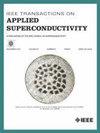Fabrication of a Nb-Ti Superconducting Closed-Loop Coil for the Next-Generation 45 GHz ECR Ion Source MARS-D
IF 1.7
3区 物理与天体物理
Q3 ENGINEERING, ELECTRICAL & ELECTRONIC
引用次数: 0
Abstract
Electron Cyclotron Resonance Ion Sources (ECRISs) that utilize Nb-Ti superconducting coils for 28 GHz frequencies have been operating effectively for over twenty years. However, transitioning to higher frequencies demands stronger magnetic fields, and the conventional racetrack-and-solenoid ECRIS structures have reached their maximum capability with Nb-Ti. To address this, a Mixed Axial and Radial field System Demonstrator (MARS-D) is being developed at Lawrence Berkeley National Laboratory (LBNL). This system features an innovative Closed-Loop Coil (CLC) design that optimizes the use of the conductor fields, enabling the application of Nb-Ti in the next-generation 45 GHz ECRISs. The fabrication of the hexagonal CLC is particularly challenging due to its complex winding path and shape, the stiffness of the Nb-Ti superconducting wire, and the small bending radius. To address these challenges, a series of unique fixtures and tools, as well as a pre-over-bending method, were developed for winding the CLC. To validate the winding fixtures, tools, procedures, and materials used in the coil assembly, a 4-layer practice CLC was wound, epoxy-impregnated, and then cold-tested using liquid nitrogen. The full-size MARS-D CLC is in the process of winding. This paper presents the structure of the MARS-D CLC, the winding fixtures and tools, the winding procedures, the quality control, the impregnation, the test results, and the potential future improvements.求助全文
约1分钟内获得全文
求助全文
来源期刊

IEEE Transactions on Applied Superconductivity
工程技术-工程:电子与电气
CiteScore
3.50
自引率
33.30%
发文量
650
审稿时长
2.3 months
期刊介绍:
IEEE Transactions on Applied Superconductivity (TAS) contains articles on the applications of superconductivity and other relevant technology. Electronic applications include analog and digital circuits employing thin films and active devices such as Josephson junctions. Large scale applications include magnets for power applications such as motors and generators, for magnetic resonance, for accelerators, and cable applications such as power transmission.
 求助内容:
求助内容: 应助结果提醒方式:
应助结果提醒方式:


